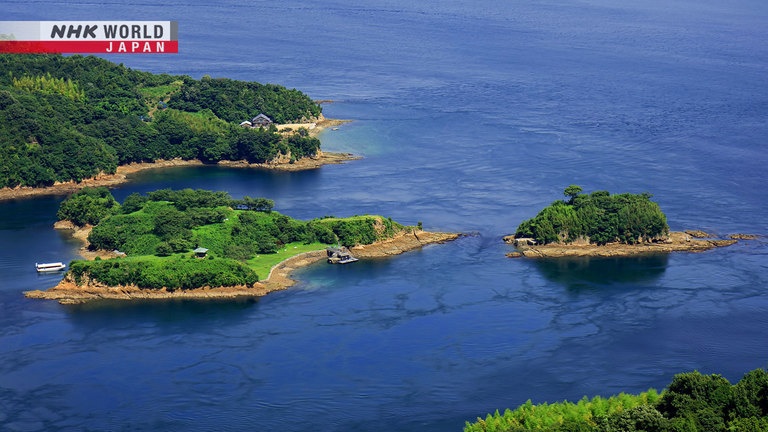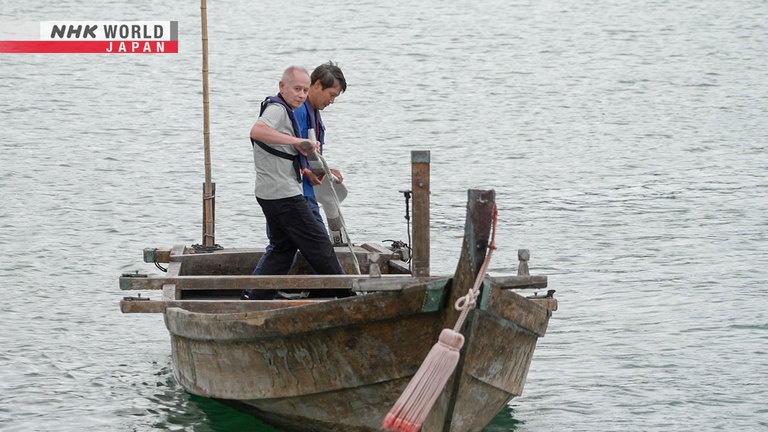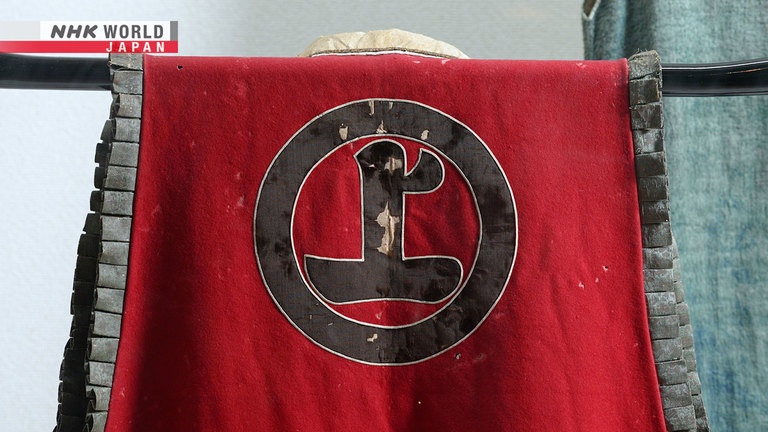The Samurai of the Sea: Pirates or Protectors?
*First broadcast on December 8, 2022.
Around 500 years ago, sea traffic in the Seto Inland Sea was monitored and controlled by a group called the "Murakami Kaizoku." The word "kaizoku" translates to "pirates," but these seafarers weren't thieves; they actually helped to keep the area safe. In the first of two episodes about the Murakami Kaizoku, museum curator Tanaka Ken tells us about their activities, and takes us to a former kaizoku stronghold. We learn about their incredible seamanship, and their cultural sensibilities.



Transcript
Hello, and welcome to Japanology Plus.
I'm Peter Barakan.
The body of water you see behind me
is called the Seto Inland Sea.
It lies between
the islands of Honshu and Shikoku
and contains a large number
of smaller islands,
some of which you'll see in the distance.
The bridge down there is part of a road
called the Shimanami Kaido,
which has ten bridges in all.
It connects Honshu and Shikoku
via smaller islands.
It's about 60 kilometers long in all,
and it's also known as
one of the world's best cycling roads.
It opened in 2006.
But our story today
goes back much further than that.
In fact, about 500 years ago,
when this whole area was controlled
by a group called the Murakami Kaizoku.
Now the word “kaizoku”
translates as “pirates.”
That has an image of hijacking galleons
and making your victims walk the plank
and all that kind of stuff.
Now the Murakami Kaizoku apparently
were not like that.
What were they up to?
That's what we're going
to try and find out
in this first episode of
what's going to be a two-part series.
Hello, Tanaka-san.
Hello.
Nice to meet you.
On behalf of the Murakami Kaizoku Museum,
welcome.
Our guide will be Tanaka Ken,
the museum's curator,
and a leading expert
on the Murakami Kaizoku.
We begin with a boat trip.
We're going to
visit an important location.
Whereabouts did these kaizoku live?
Do you see that island ahead,
with a flat area on top?
That was the site of Noshima Castle,
one of their operational bases.
That's a castle?
Well, it's the remains of a castle.
Noshima has a perimeter
of just 800 meters.
And there's an even smaller island
right next to it.
In the 14th to 16th centuries,
a period of great turbulence in Japan,
the Murakami Kaizoku controlled
these two islands.
They were chosen
for their great natural defenses.
The current's really quite strong
around here, isn't it?
Yes. But it gets stronger.
It can flow up to twice as fast as this.
Wow!
So that would actually be quite dangerous.
Absolutely, yes.
These days,
boats are equipped with engines,
but 400 years ago,
they didn't have that luxury.
Right.
The waters of the Seto Inland Sea
are mostly quite calm.
But near Noshima,
where the water has to squeeze
through narrow channels,
the tidal flow is powerful.
And there are many submerged rocks,
making the islands extra
difficult to approach.
From the perspective of
the military leaders on the island,
the strong current
created an effective moat.
It made Noshima Castle
very hard to attack.
Ah.
The Kaizoku occupied Noshima
for around 250 years,
between the 14th and 16th centuries.
Today, it is uninhabited,
but back then, around 200 people
are thought to have lived here.
Evidence of habitation,
such as land development,is still visible.
It's just big enough
for one person to walk up here.
Yes.
OK. We're actually quite a long way up,
aren't we?
We are.
Previously, people believed that
the kaizoku didn't actually live here,
in Noshima Castle.
They thought the island
was simply used as a lookout point,
and as a place to dock boats.
But excavations revealed evidence
that a large number of kaizoku
did indeed live here.
OK.
What sort of stuff was found
when you started excavating?
We found the remains of many buildings
from that time.
We also discovered dishes used
when applying makeup,
and small, round pieces of pottery
that appear to have been used
in children's games.
So there's evidence
that women and children lived here, too.
So it would have been whole families.
We believe so.
Here's an object that tells us about
a certain custom practiced by the kaizoku.
Looks like the little saucers
that people put soy sauce in.
Well, it is a saucer,
but not for soy sauce.
What do you think it's for?
I've no idea.
It's for drinking sake.
OK.
In Japanese, it's called “kawarake.”
Kawarake? Never heard of that.
It was a time of conflict.
Warriors would drink sake to pray
for success on the battlefield.
It was a kind of ritual.
So it's for ceremonial use.
Yes.
A saucer like this was used just once,
and then thrown away.
Ah.
Discarded kawarake were concentrated
in certain areas of the castle.
And the place with the most
was the central keep.
We found around 12,000 fragments
of pottery there,
of which 95 percent belonged to kawarake.
You can picture them sipping sake.
Drinking together might strengthen bonds,
or maybe they discussed strategy.
The keep was a special place.
OK.
Now we go up to where
that central keep once stood,
on the highest part of the island.
From here, you can look out
across the Seto Inland Sea.
This vantage point was essential
to the activities of the Murakami Kaizoku.
They could observe all
the vessels passing nearby.
Then, as now, the Seto Inland Sea saw
a great deal of traffic.
The red lines show frequently used routes
in the area between Kyushu,
to the west, and Osaka, to the east.
The shortest route would often
take vessels past Noshima.
That made the island
a vital strategic location.
The Murakami Kaizoku also built castles
at Kurushima and Innoshima,
allowing them to monitor almost
every vessel moving through these waters.
How did the kaizoku—the pirates—
ply their trade
back in the 14th, 15th, 16th centuries?
They imposed a toll on all of the ships
passing through their territory.
That's how they made a living.
And did they resort to violent means
to get people to pay?
They wouldn't attack without warning,
and hijack a vessel or seize its cargo.
First, they'd hold discussions with a
boat's captain about the size of the toll.
They'd negotiate.
If those negotiations broke down,
that's when the kaizoku would get tough.
Their bases operated like checkpoints.
And when the kaizoku got paid,
they didn't just let boats through.
They also guaranteed their safe passage.
It's a bit like
the old American mafia movies
where you pay protection money.
Well, the currents
were fast and treacherous.
This was a time of conflict
when it was hard to know who to trust.
But if you wanted to safely cross
the Seto Inland Sea,
it was best to comply
with the kaizoku's rules.
Doing things their way kept you safe.
Ah, OK.
The kaizoku offered protection
in two ways.
One method involved a kaizoku member
boarding a boat personally.
They'd take it through to safety.
So like a pilot?
Yes, like a pilot.
The second method came later,
at a time when sea traffic had increased.
Perhaps the kaizoku
didn't have enough pilots.
They handed out flags bearing their mark.
A ship flying that flag
could move safely through the checkpoints.
They implemented that system.
Ah, OK.
As long as you had permission,
you were able to travel safely.
That was another way
the Murakami Kaizoku did things.
How long have kaizoku existed in Japan?
In written records,
the word first appeared
in the 9th century.
Here's an excerpt
from a history book written at the time.
They attacked villages and boats.
The people who did this
became known as “kaizoku.”
The authorities started trying
to crack down on them.
That was the beginning of kaizoku
in Japan.
In the 16th century,
a Portuguese missionary
called Luís Fróis traveled to Japan.
He wrote about the evil deeds
of a pirate named Fukahori, in Nagasaki.
But Fróis had a very different impression
of the Murakami Kaizoku.
He wrote positively about their attitude
towards a missionary who visited Noshima.
How were the Murakami Kaizoku
different from the other pirates?
In return for payment of a toll,
they guaranteed safe passage.
There's no evidence of
other kaizoku ever doing that,
in places like Izu or Kyushu.
That behavior may be unique
to the Murakami Kaizoku.
The Murakami Kaizoku emerged
in the 14th century.
At first, they served as guards
on cargo vessels.
The boats transported salt,
which was produced around
the Seto Inland Sea.
The Murakami Kaizoku
knew the local waters extremely well,
and they began to act as pilots for lords
and merchants traveling through them.
In the 16th century,
they rose to new heights under the expert
leadership of Murakami Takeyoshi.
Soon the Murakami Kaizoku were guardians
of the entire Seto Inland Sea.
But why were they so knowledgeable
about the local waters in the first place?
There's a clue on the beach at Noshima.
Have a look at this.
Pools of water, but intentionally made.
What are these?
These were for wooden poles.
They were used for mooring boats.
So they would tie their...
tie their boats up to poles here
in the rocks on...by the beach.
OK, that makes sense.
Just a couple of those.
Actually, around 400 of these
have been found on the island.
400? On a small island like this?
That's a lot.
In fact, a regular part of the kaizoku
lifestyle was catching fish to eat.
They were fishermen?
Yes.
And of course, if they're plying
their trade as fishermen in these waters,
day in, day out, year after year,
they obviously know the waters
probably better than anybody else,
which puts them in a very good position
for guiding other people through here.
You're absolutely right.
They understood the movements of the tide,
and they could estimate
the depth of the water.
They knew the location of rocks lurking
just below the surface.
They knew every detail.
And that knowledge came in
very useful during times of conflict.
When acting as pilots, they were able to
share that knowledge with their clients.
So the know-how
they accumulated while fishing
became the foundation of their business.
Back then,
ships were the most important way
to transport goods,
and so control of the Seto Inland Sea
was extremely lucrative.
It was an age of exploration,
when different cultures
spread throughout the world.
And the Murakami Kaizoku, too,
were exposed to foreign influences.
Those influences are evident
in a rare object in the museum.
Here it is.
It looks slightly different from
the normal kind of clothing
you see from Japan.
It's a battle surcoat,
worn by military leaders over their armor.
Within the circle
we see the mark of the Murakami Kaizoku.
We did some research into the dye
that was used to produce
the red color of this garment.
And we found that it was made using
an insect called a cochineal,
from a family of bugs
called “scale insects.”
It turns out that those insects
were originally farmed
in Central and South America.
You find them on cactus plants.
Another detail is the decoration
on the sleeves.
This style wasn't seen elsewhere
in Japan at that time.
We don't know
which country this influence came from.
But some experts think
it's somewhere in Europe.
Interesting. Obviously,
they were sufficiently influenced
that it would change
the style of clothing.
The Seto Inland Sea was the setting
for a constant flow of people,
goods and information.
The Murakami Kaizoku would have been right
on top of the latest developments.
They'd be in a great position to
adopt anything new that appealed to them.
Through their activities,
the Murakami Kaizoku were exposed to
the ruling elite and international trends.
They acquired a refined sense of culture.
There's evidence
that they practiced the tea ceremony.
Flutes used in noh theater and
old court music have also been discovered.
They took spirituality seriously, too.
To learn more,
we're visiting a nearby shrine.
It's called Oyamazumi Shrine,
and it's located in an area
once controlled by the Murakami Kaizoku.
It has over 2,600 years of history,
and the sacred tree
in the center of the precinct
is said to have stood here
from the beginning.
Hello. Nice to meet you.
Good morning.
This is the chief priest.
So tell me a little bit about your shrine.
It's dedicated
to the deity Oyamazumi no Okami,
who is worshipped around the country
as a god of the mountains.
But at this shrine,
we also worship the same deity
as a god of the sea—
responsible for the safe
passage of people and goods.
The Murakami clan themselves
would have worshipped this deity.
Oyamazumi no Okami has another role
as a deity of warfare.
In the past,
warriors presented weapons and armor
to the shrine, as offerings.
One of the weapons, a naginata,
is thought to have belonged
to the Murakami.
This exhibit draws attention
to the clan's cultural sensibilities.
It's a type of linked verse.
Linked verse was made collaboratively,
and then dedicated to the deities.
A group of people
would take turns to compose verses.
For each person,
this meant reflecting
on the previous verse,
and then adding something appropriate.
It was a sophisticated activity.
What kind of content is it?
Is it religious in content?
They'd think up a theme that seemed right
for the circumstances of each occasion.
It wasn't just religious content.
This kind of linked verse wasn't created
only by leading figures
of the Murakami Kaizoku.
Ordinary local people took part too.
People from all walks of
life composed poetry together.
So the whole society had a fairly highly
evolved aesthetic sense.
The fact that they composed poetry
does point in that direction, yes.
The Murakami Kaizoku flourished
in the 15th and 16th centuries—
a time of near-constant
regional turbulence.
Feudal lords, impressed
by their seamanship,
saw them as “the samurai of the sea,”
and often sought their military support.
The boats
that the Murakami Kaizoku generally used
were small vessels like this.
We asked a local fisherman to
show us how to pilot one.
I won't last five minutes on this.
It's really…it's not hard to do,
but it's just really heavy.
Why did the Murakami Kaizoku
choose to have boats like this?
I mean, you wouldn't think of something
like this for fighting, would you?
By skillfully piloting these small boats,
the Murakami Kaizoku
could freely change formation,
allowing them to engage even
with battleships.
Another important factor
in naval conflict was tidal currents.
Reading them correctly
was a key to victory.
The Murakami Kaizoku clearly had
expert knowledge of the tides.
Here's a document that helps to explain
their incredible seamanship.
This was compiled later as an account
of the Murakami Kaizoku's knowledge
of the sea, their battle tactics,
and so on.
There's one page in particular
I want to show you.
Here it is.
It shows the times of low and high tides.
Around the edge, we see
the 12 signs of the traditional zodiac.
Think of them as a clock.
Here, a window is cut into the paper.
We can see a date.
And we can rotate the paper.
Let's adjust it by a few days.
Now, it says that
on the first day of the month,
the high tide is between
the hours of the ox and the tiger.
Six hours later is the low tide.
The time of high tide and low tide
changes gradually as the days go by.
The Murakami Kaizoku
accumulated that knowledge,
and shared it across the generations.
We take all of this sort of stuff
for granted now,
but this was happening back
in probably like the 15th century.
Yes, we can be fairly sure
that they had this knowledge
in the 15th and 16th centuries.
Fascinating.
The “zoku” part of “kaizoku”
means “people who steal things,”
but that doesn't really apply to
what the Murakami Kaizoku were doing.
So why were they called “kaizoku”
in the first place?
When you look at how they made a living,
it may be true that
they weren't simply thieves.
But they certainly did
have a fearsome side to them.
We're talking about a period of
nationwide turbulence, after all.
Were they associated
with any particular power group?
It seems they adapted to circumstances.
For a time, they might associate
with one warlord,
and then later distance themselves again.
They were relatively free.
Sometimes they were employed
as mercenaries.
They served as a professional
fighting unit, available for hire.
So they were basically businessmen.
It wasn't like
they had a particular mission
that they were trying to pursue.
Or at least,
their mission and their business goals
weren't completely separate.
They pursued their business ventures
in order to look after
family and community.
They wanted to protect the local area—
the place where they were born.
Their activities were an essential
way of doing that.
Trying to steer that boat a while back
was definitely a wake-up call.
Even within the walled harbor,
the boat drifts unless you're constantly
keeping it under control.
Once you go outside into the open water,
without some kind of a guide,
you're going to be totally at
the mercy of the ever-changing currents.
It was very obvious
that the Murakami Kaizoku
had an important part to play
in maintaining
the safety of this inland sea.
In the second part of this series,
we'll take a further look
at the activities of the Murakami Kaizoku
and their legacy in the present day.